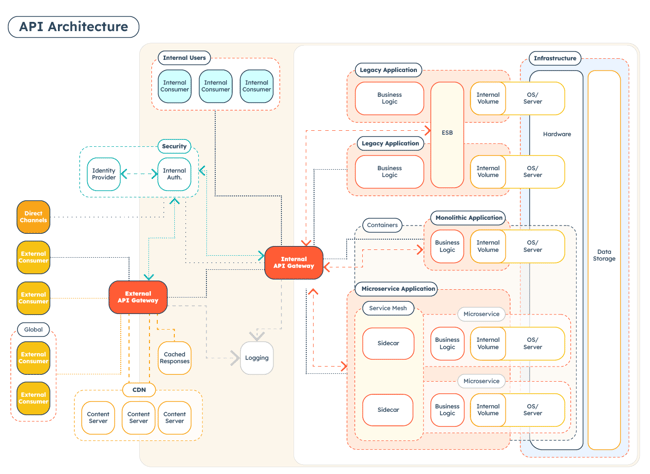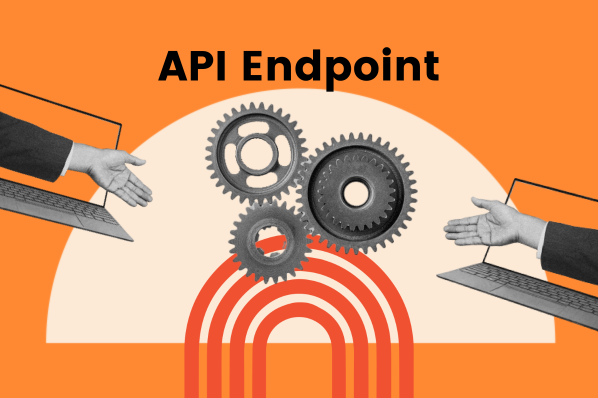Consumer demands and advancements in information networking have led to a transition to the use of API-based architectures in many applications. Modern products often provide real-time experiences for geographically distributed audiences using asynchronous data transfer and virtualized, always-available infrastructures.

Currently, API development begins alongside the start of a project, building end-user accessibility and easy maintenance into the application’s design.
Contemporary API creation focuses on creating interconnectivity among diverse software systems and replacing modular legacy designs. These APIs expose resources managed as containerized microservices, which continually adapt to the changing demands of customers and connected software.
Best Practices for Effective API Development
In general, don’t try to invent new ways to do things that already have established best practices and well-supported implementations. Most existing API conventions are based on the same underlying standards and technologies for a good reason.
Many representational state transfer (REST or RESTful) APIs are built on the OpenAPI standard, which entails gathering information about the needs of consumers first, then designing an API to meet those needs, and finally writing the code. This is also an excellent approach to apply to other architectures.
Your API should also ensure its continuing relevance. You can maintain backward compatibility by using version numbers and only adding fields to an API rather than removing or renaming them. This enables users to update their applications and continue using existing Uniform Resource Identifiers (URIs) to retrieve resources.
To ensure your API continues to support the evolving needs of your developers, plan for potential use cases. In a RESTful API, for example, providing options to filter, sort, and paginate results keeps your API relevant as you add data and functionality.
1. Think about the architecture.
Selecting an appropriate API depends on your application’s functional and non-functional requirements.
Functional requirements meet the needs of your consumers. Rather than basing design decisions on how your application works, collect data about how your end users will consume your API. Your API should present options relevant to your client’s process — not your back-end decisions.
Back-end concerns are your API’s requirements, which depend on your application’s underlying technologies. These requirements include ease of development and testing, security, scalability, and the rest of the API lifecycle.
Types of APIs
First, determine which type of API your application needs. Larger projects and products intended for public consumption often require a mix of various kinds of APIs.
- Open APIs (public APIs) expose a product or service directly to external clients. These APIs are available to anyone, so it’s good practice to limit the resources they reveal.
- Partner APIs provide a limited set of data and functionality to specific clients. Clients typically have a business relationship with the provider. These APIs are common in software-as-a-service (SaaS) products and third-party maintenance contracts. When developing a partner API, enforce more robust security measures and expose more resources than you would through an open API.
- Internal APIs (private APIs) provide data or services, typically tools, to clients within an organization. They aren’t visible to the public and are typically used to communicate between teams, systems, or applications within the organization. Give extra consideration to the security of your internal APIs, as they’re often overlooked but can cause the most significant damage when compromised. Zero-trust or other perimeter-less security measures are excellent choices.
- Composite APIs allow users to make multiple simultaneous requests to numerous endpoints. They’re common in microservice architectures for user-facing applications. Examples include online user account creation, e-commerce transactions, and data retrieval from cloud storage.
Know Your Limits
You should also consider what your API shouldn’t handle. For example, an API sometimes needs to expose specific raw data but shouldn’t handle UI concerns.
To address the challenge of retrieving highly specific data with customizable requests using a RESTful API, you can use GraphQL.
GraphQL is a server-oriented query and runtime language for composite API architecture. It describes server-side data using schemas, letting clients submit complex queries to request specific data that may come from several endpoints before being assembled for return.
API creation for a composite architecture requires careful planning to avoid exposing security vulnerabilities when your clients access data. You can simplify this planning process by using schemas to provide data, authorization validation, and documentation. And speaking of documentation …
2. Document everything.
Documentation is essential for internal reference as your team develops an API and for consumers to understand its capabilities.
As you build your API, you can use modern API documentation websites, whose tools allow you to try out your API in real time to ensure your documentation is accurate.
Documentation should begin the moment you start designing your API, and it should extend beyond low-level implementation details to include higher-level architectural decisions. You can record these decisions using architectural decision records (ADRs).
ADRs provide an auditable record of the reasoning behind your choices regarding security, frameworks, standards, and functionality. This creates more continuity and cohesion within the development team. You can also present them as user-facing documents to help developers align with your API design philosophy.
Documentation is even more critical if your API uses the simple object access protocol (SOAP). In contrast to APIs following REST guidelines, SOAP APIs are heavily customizable and specific to each implementation. Because SOAP APIs are often used internally, it can be tempting to skip some documentation. However, it’s best practice to create thorough documentation, as though the API were public-facing.
3. Test often.
Frequently test your API during development to understand how each new feature impacts its functionality and address potential security vulnerabilities. The broad range of available API testing tools covers many scenarios and includes popular tools like Postman, SoapUI, Katalon Studio, and Swagger.
Use stubbed code to test more specific parts of your API. Stubs are pieces of code used to stand in for some other programming functionality, allowing you to assume that certain conditions have been met or states achieved. A well-designed API uses real data, preferably based on ethically collected use.
In code, stubs and standard test suites prefer dynamic assertions to hardcoded data values, as they give you more flexibility during testing and are less likely to be forgotten and cause bugs in production. If you need hardcoded values, include these in your documentation.
You can also repurpose existing tools. With a few adaptations, you can often apply data-driven functional tests to API testing.
4. Create effective and descriptive error codes.
Your documentation suite should also include logs of your test results for successful outcomes and failed tests. When adding to your API in the future, a comprehensive record allows you to predict expected interactions and design for them. Make sure to log failed communication attempts, which often produce less verbose or even silent feedback.
To extract more value from your logs, document errors thoroughly. Your error codes should be descriptive and, whenever possible, actionable. RESTful APIs use standard HTTP error codes, which might not be precise enough to let your users efficiently resolve them.
Some protocols provide more comprehensive error code suites. For example, error codes in Google Remote Procedure Calls (gRPC) are a superset of HTTP error codes fine-tuned for use in APIs.
5. Use an API Gateway
An API gateway acts as a front end for an API, providing a single entry point for clients. Unlike an API proxy, it performs crucial additional functions.

An API gateway lets you combine different API technologies to use the best framework for each context.
For example, you might expose your application’s resources through a user-facing RESTful API but route traffic through your enterprise inventory system using a SOAP API. Your users interact with a well-documented, predictable, web-friendly interface when a specialized API that integrates your legacy systems handles your internal business logic.
An API gateway is valuable for APIs intended for mobile platforms. It handles the processing overhead of routing logic and reduces the number of round trips the client needs to initiate to retrieve data. GraphQL APIs, in particular, benefit from this design pattern. Event-driven architectures, such as those built using Node.js, can also include API gateways and let your application scale.
Notably, an API gateway also functions as a security enforcement point, handling API keys, OAuth, and other tokens and enforcing rate limiting and throttling. It’s still best practice to implement perimeter-less security, especially if you’re using a gateway as the interface point between a public-facing API and your internal systems.
However, an API gateway provides a natural opportunity to strengthen your security, and its position as a central routing point lets you record network data in your logs.
Working with APIs, the Right Way
API development best practices are crucial to developing effective applications. A thoughtfully designed API keeps your developers cohesive by directing them toward the needs of your end users. It significantly reduces the development cost and produces well-documented, easy-to-use, and lean APIs that ensure the best developer experience for users.
![Download Now: An Introduction to JavaScript [Free Guide]](https://no-cache.hubspot.com/cta/default/53/52e488f1-9b65-4968-b59f-38009a1c92a3.png)





![What is Payload? A Quick Guide [+ Examples]](https://blog.hubspot.com/hubfs/payload.webp)


